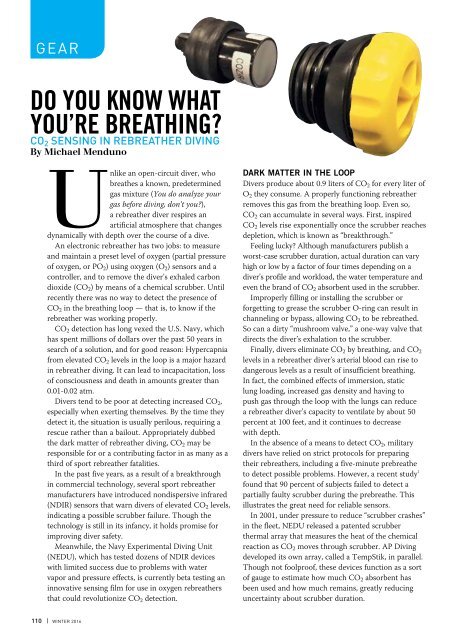AD 2016 Q1
You also want an ePaper? Increase the reach of your titles
YUMPU automatically turns print PDFs into web optimized ePapers that Google loves.
GEAR<br />
DO YOU KNOW WHAT<br />
YOU’RE BREATHING?<br />
CO 2 SENSING IN REBREATHER DIVING<br />
By Michael Menduno<br />
Unlike an open-circuit diver, who<br />
breathes a known, predetermined<br />
gas mixture (You do analyze your<br />
gas before diving, don’t you?),<br />
a rebreather diver respires an<br />
artificial atmosphere that changes<br />
dynamically with depth over the course of a dive.<br />
An electronic rebreather has two jobs: to measure<br />
and maintain a preset level of oxygen (partial pressure<br />
of oxygen, or PO 2 ) using oxygen (O 2 ) sensors and a<br />
controller, and to remove the diver’s exhaled carbon<br />
dioxide (CO 2 ) by means of a chemical scrubber. Until<br />
recently there was no way to detect the presence of<br />
CO 2 in the breathing loop — that is, to know if the<br />
rebreather was working properly.<br />
CO 2 detection has long vexed the U.S. Navy, which<br />
has spent millions of dollars over the past 50 years in<br />
search of a solution, and for good reason: Hypercapnia<br />
from elevated CO 2 levels in the loop is a major hazard<br />
in rebreather diving. It can lead to incapacitation, loss<br />
of consciousness and death in amounts greater than<br />
0.01-0.02 atm.<br />
Divers tend to be poor at detecting increased CO 2 ,<br />
especially when exerting themselves. By the time they<br />
detect it, the situation is usually perilous, requiring a<br />
rescue rather than a bailout. Appropriately dubbed<br />
the dark matter of rebreather diving, CO 2 may be<br />
responsible for or a contributing factor in as many as a<br />
third of sport rebreather fatalities.<br />
In the past five years, as a result of a breakthrough<br />
in commercial technology, several sport rebreather<br />
manufacturers have introduced nondispersive infrared<br />
(NDIR) sensors that warn divers of elevated CO 2 levels,<br />
indicating a possible scrubber failure. Though the<br />
technology is still in its infancy, it holds promise for<br />
improving diver safety.<br />
Meanwhile, the Navy Experimental Diving Unit<br />
(NEDU), which has tested dozens of NDIR devices<br />
with limited success due to problems with water<br />
vapor and pressure effects, is currently beta testing an<br />
innovative sensing film for use in oxygen rebreathers<br />
that could revolutionize CO 2 detection.<br />
DARK MATTER IN THE LOOP<br />
Divers produce about 0.9 liters of CO 2 for every liter of<br />
O 2 they consume. A properly functioning rebreather<br />
removes this gas from the breathing loop. Even so,<br />
CO 2 can accumulate in several ways. First, inspired<br />
CO 2 levels rise exponentially once the scrubber reaches<br />
depletion, which is known as “breakthrough.”<br />
Feeling lucky? Although manufacturers publish a<br />
worst-case scrubber duration, actual duration can vary<br />
high or low by a factor of four times depending on a<br />
diver’s profile and workload, the water temperature and<br />
even the brand of CO 2 absorbent used in the scrubber.<br />
Improperly filling or installing the scrubber or<br />
forgetting to grease the scrubber O-ring can result in<br />
channeling or bypass, allowing CO 2 to be rebreathed.<br />
So can a dirty “mushroom valve,” a one-way valve that<br />
directs the diver’s exhalation to the scrubber.<br />
Finally, divers eliminate CO 2 by breathing, and CO 2<br />
levels in a rebreather diver’s arterial blood can rise to<br />
dangerous levels as a result of insufficient breathing.<br />
In fact, the combined effects of immersion, static<br />
lung loading, increased gas density and having to<br />
push gas through the loop with the lungs can reduce<br />
a rebreather diver’s capacity to ventilate by about 50<br />
percent at 100 feet, and it continues to decrease<br />
with depth.<br />
In the absence of a means to detect CO 2 , military<br />
divers have relied on strict protocols for preparing<br />
their rebreathers, including a five-minute prebreathe<br />
to detect possible problems. However, a recent study 1<br />
found that 90 percent of subjects failed to detect a<br />
partially faulty scrubber during the prebreathe. This<br />
illustrates the great need for reliable sensors.<br />
In 2001, under pressure to reduce “scrubber crashes”<br />
in the fleet, NEDU released a patented scrubber<br />
thermal array that measures the heat of the chemical<br />
reaction as CO 2 moves through scrubber. AP Diving<br />
developed its own array, called a TempStik, in parallel.<br />
Though not foolproof, these devices function as a sort<br />
of gauge to estimate how much CO 2 absorbent has<br />
been used and how much remains, greatly reducing<br />
uncertainty about scrubber duration.<br />
110 | WINTER <strong>2016</strong>









